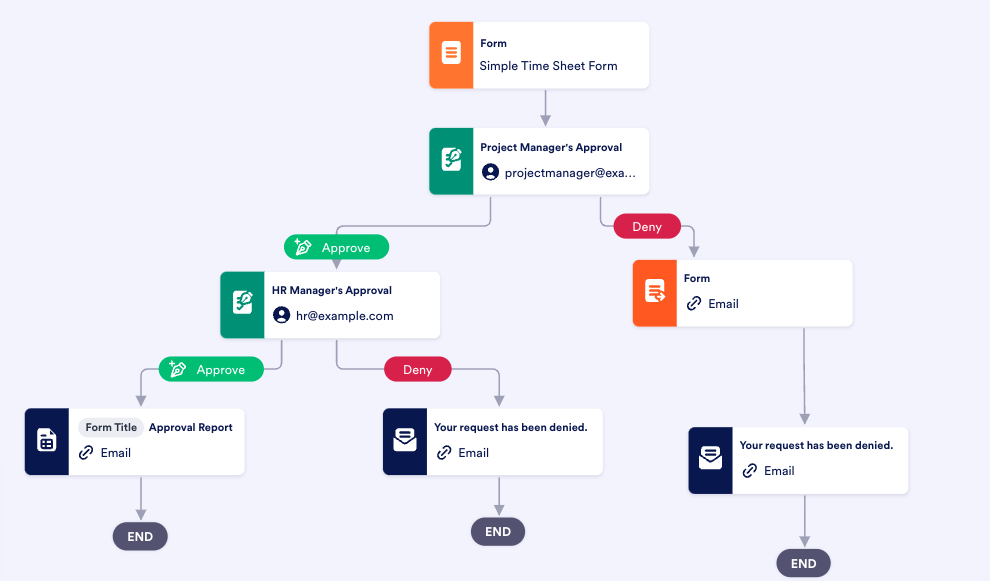Though it feels like technology has dramatically shifted working life, the way many workers clock in and out is still straight out of the 19th century.
After Willard Legrand Bundy invented the employee time clock in the 1880s, the practice of mechanically tracking worker hours didn’t change significantly until the internet came along. Yet as of 2017, 17 percent of small businesses were still using time clocks, and 20 percent were using paper timesheets.
Clocking in and out or filling in timesheets sounds simple, but managing manual systems is anything but. Companies that use paper or even Excel sheets to track hours have to spend unnecessary time and money approving timesheets. In 2015, professional automation services company AffinityLive estimated that workers in the United States alone waste more than 50 million hours a day on unproductive tasks like manual timesheet management.
The solution for managers is to automate the timesheet approval process.
What is timesheet approval automation?
The slow procedure of filling in timesheets and then sending them to a manager for approval can be a stumbling block to productivity, especially when managers have to touch base with employees to correct errors.
The fix is to automate as many steps in the approval process as possible with free or paid timesheet software platforms. These programs can email timesheet reminders, mock up invoices, send timesheets to managers, handle multiple billing rates, and integrate with other management tools.
What are the benefits of automating timesheet approval?
Many workplace technologies have cut down on inefficient manual tasks and helped organizations improve productivity. An automated timesheet approval process is no different. Here are some of the benefits.
Open communication
An automated system keeps everyone on the same page. With a system that facilitates and speeds up communication, workers can easily resolve problems and discrepancies. This gives employees the confidence of knowing their work hours are correct and their compensation is fair.
Fewer mistakes
The American Payroll Association calculates that the error rate for time cards can be as high as 8 percent, ultimately translating to more than 10 percent of work time spent correcting these errors.
Automation reduces error rates, helping ensure compliance with the Fair Labor Standards Act, which mandates accurate records of employees’ hours.
Streamlined work time
When the tedious elements of work are automated, team members can focus on their projects. With a straightforward timesheet approval process, workers are less distracted, and managers don’t have to interrupt important work to discuss timesheets.
Having instant access to all timesheets can also help organizations predict how much time teams will need to dedicate to future assignments.
Accessibility
With the rise of remote work, employees and managers need timesheets that they can fill out or approve anytime, anywhere. With automation software and applications, workers can clock in or out wherever they’re working.
How to create a timesheet approval process
The time and efficiency gained by automating timesheets are well worth the effort it takes to put together a new system. Here’s how to do it.
Set up rules and deadlines
Define standards so employees and managers know what to expect. This includes establishing dates and timelines for payroll processing, timesheet approval deadlines, paydays, and more. You also need to outline best practices for when employees work more than or less than 40 hours, depending on whether or not they’re salaried.
These rules will become the skeleton of the timesheet approval workflow. To ensure each step in the workflow makes sense, ask yourself who has which responsibilities and what rules they follow. Knowing the answers is a precursor to configuring the software you’ll use.
Don’t forget to allow for exceptions and unusual circumstances. For example, who will approve timesheets when managers are on vacation or out sick? Which human resources team members will receive timesheets and for which departments? What steps should team members follow to correct mistakes?
Select a system
Aside from having your rules and workflow down, the most important step is choosing your automation tool. If you have the resources, an IT department can assist in building an in-house timesheet approval software.
There are also timesheet software and application options on the market, such as QuickBooks Time. Or you can purchase a subscription to a cloud-based human resources tool.
Make sure you can adapt program features to your workplace. For example, software company Pacific Timesheet recommends using timesheet software that will be able to keep up with changing needs.
Test the system
Before moving forward, do a test run with your team to make sure the new automated process works for them. This way, you’ll be able to observe any gaps or issues in the process before full implementation. Testing will also give you the chance to switch to a different program if necessary. Be open to modifying and improving the software settings and the approval workflow as needed.
Automating timesheet approvals with Jotform Approvals
If you want to create a timesheet approval process yourself without investing your IT department’s time in building a tool, give Jotform Approvals a try. Setting up an approval process is as easy as dragging and dropping a few elements.
With Jotform Approvals, you can customize each step of the approval process by setting up automatic emails, assigning and managing approvers, and using conditional logic for more complicated workflows.
Just start with one of Jotform’s timesheet form templates, which you can customize to your needs, or build your own with the drag-and-drop Form Builder. Then collect all the information you need to keep your approval workflow running.
Jotform consolidates your timesheets into a single database, so you never lose track of worker hours. All employees have to do is update their hours from any device, and the information goes straight to your Jotform account, where you can view the data in different layouts, such as calendar or spreadsheet.
Jotform simplifies necessary but tedious business tasks — so you can spend more time on the work that matters.






























Send Comment: